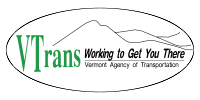Vermont Agency of Transportation
 | |
| Agency overview | |
|---|---|
| Preceding agencies |
|
| Jurisdiction | Vermont |
| Headquarters |
1 National Life Drive Montpelier, Vermont |
| Agency executives |
|
| Parent agency | State of Vermont |
| Website | http://Vtrans.vermont.gov |
The Vermont Agency of Transportation (VTrans) is a government agency of the state of Vermont that is responsible for planning, constructing, and maintaining a variety of transportation infrastructure in the state. This includes roads, bridges, state-owned railroads, airports, park and ride facilities, bicycle facilities, pedestrian paths, public transportation facilities and services, and Department of Motor Vehicles operations and motor carrier enforcement.
Responsibility
The federal government has provided most of the money to construct federal (Class I) highways but the state has the responsibility to maintain them. The state, in turn, builds state (Class II) roads and it is up to the local towns and municipalities to maintain them.[1]
History
The Vermont State Highway Commission was established in 1892. A six year study by the commission led to the establishment of state funding for the construction of new roads in 1898. A new State Highway Board was created in 1921 consisting of the governor and two appointed officials. Two years later, the board created the Department of Highways. In 1960, several organizations including the Commissioner of Highways, the State Highway Board, and the Board of Public Works were merged into the Department of Highways. In 1973, a Transportation Advisory Board was established and tasked with assessing all existing transportation organizations and developing a ten-year plan for state transportation. From the recommendations of the board, a new Agency of Transportation was created as the central authority of transportation in Vermont in 1975. The new agency was headed by a seven member Transportation Board. Changes in leadership structure, divisions, and committees in 1986 established the agency as it currently stands.[2]
Structure
The agency divides the state into four regions: Northwest, Northeast, Southwest, and Southeast. Each region is further divided into two maintenance districts. Each maintenance district has a district headquarters. The agency's main headquarters serves an additional district, for a total of nine districts statewide.[2]The agency employs 1,300 people It is divided into three main divisions as well as an associated department. They are:[3]
Highway Division
The Highway Division is primarily responsible for the construction and maintenance of Vermont's road system. Its tasks also include installing and maintaining signals, signs, and culverts, providing grants and support for municipal level projects, maintaining the agency's fleet of vehicles, providing safety training, and informing the public of road conditions.
Division of Policy, Planning, and Intermodal Development
The PPID oversees other means of transportation in the state. Railways, airports, and public transportation are under its supervision. It is also responsible for creating future plans and prioritizing projects. It collaborates with other councils and the general public.
Division of Finance and Administration
This Division performs the administrative functions of the agency. Its tasks include negotiating contracts, information technology support, budget and accounting, auditing, compliance with labor laws, and hiring.
Department of Motor Vehicles
Although not considered a division of the agency, the Vermont DMV is associated with it. The agency assists with the enforcement of DMV policy. The main headquarters are in Montpelier and there are ten other offices throughout the state.
Funding
In the 2017 fiscal year, the agency's total budget was $612,574,418. This was a decrease of 0.6% or $3.6 million from the 2016 fiscal year. It included $249,073,779 from state transportation funding, $326,665,494 in federal funding, $12,269,376 from TIB Fund $19,731,787 from the Central Garage Fund, and 4,833,982 from other sources. This was appropriated as $28.9 million for the Department of Motor Vehicles, $111.1 million for paving, $105.1 million for bridges, $31.1 million for roadway construction and improvement, $17.4 for traffic and safety, $2.6 million for construction and improvement of park and ride facilities, $10.1 million for bicycle and pedestrian facilities, $4.6 for alternative transportation, $550,000 for rest areas, $91.6 million for maintenance, $31.2 million for public transportation, $20 million for aviation, $33.9 million for rail transport, $2 million for agency facilities improvements, and $76.8 million for town highway programs.[4]
Controversy
VTrans applies a salt brine to roads to melt snow and ice. The brine has been suggested as a factor in increased corrosion of vehicles. The agency states that there is no evidence to prove this. Nevertheless, a bill was introduced in the Vermont legislature in 2017 to prevent the use of salt brine. It was passed and took effect in July of 2017.[5]
See also
References
- ↑ "NVDA glossary". nvda.net. Archived from the original on 2008-05-28. Retrieved 2009-07-09.
- 1 2 "2017 Fact Book and Annual Report" (PDF). Vermont Agency of Transportation. State of Vermont. 15 January 2017. Retrieved 15 June 2018.
- ↑ "About". Vermont Agency of Transportation. State of Vermont. Retrieved 15 June 2018.
- ↑ "FY 2017 Transportation Program" (PDF). Vermont Agency of Transportation. State of Vermont. Retrieved 17 June 2018.
- ↑ Polhamus, Mike (23 January 2017). "Bill Takes Aim at Controversial Salt Brine use on Roads". VTDigger. Vermont Journalism Trust. Retrieved 17 June 2018.